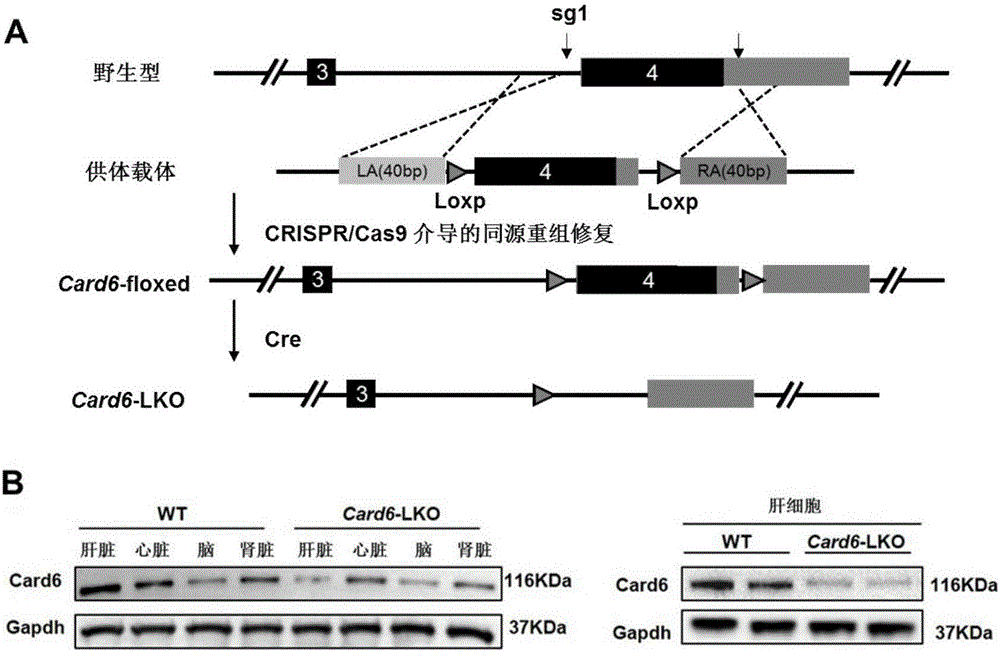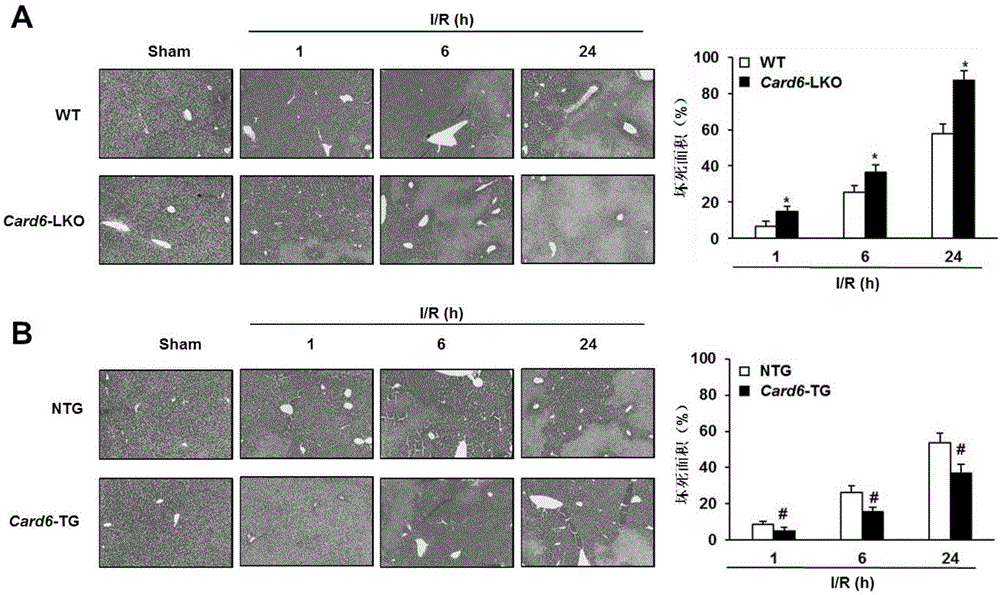Application of Caspase recruitment domain protein 6 (Card6) in hepatic ischemia reperfusion injury
A technology for reperfusion injury and liver ischemia, applied in the field of gene function and application, can solve problems such as failure to properly solve liver and injury, and achieve the effect of inhibiting liver tissue ischemia-reperfusion injury
- Summary
- Abstract
- Description
- Claims
- Application Information
AI Technical Summary
Problems solved by technology
Method used
Image
Examples
Embodiment 1
[0036] Example 1 Construction of hepatocyte-specific Card6 knockout mice and Card6 transgenic mice
[0037] (1) Construction of hepatocyte-specific Card6 gene knockout mice (see figure 1 A in
[0038] According to the information of the Card6 gene, CRISPR Design was used to design a CRISPR targeting site in the non-coding region 4 of intron 3 and exon 4 respectively. The target sequences are:
[0039] Card6-sRNA1: GgAGAGTAGGCAACATGACT TGG;
[0040] Card6-sRNA2: gGTGAAAGCAGTTATCAGTAGGG.
[0041] In addition, a donor vector (Donor Vector) for homology repair was designed, which includes homology arms on both sides, exon 4 in the middle and two loxp sequences in the same direction.
[0042] 1) Construction of targeting vector: respectively fuse two primers corresponding to sgRNA1 and sgRNA2 into double-stranded DNA, and then use T4 DNA ligase to ligate into pUC57-sgRNA (Addgene 51132) vector treated with restriction endonuclease BsaI . There is a T7 promoter upstream of the...
Embodiment 2
[0061] Example 2 Obtainment of mouse liver ischemia-reperfusion injury (ischemia / reperfusion injury, I / R) model
[0062](1) Grouping of experimental animals: male C57BL / 6 strain wild-type mice, liver cell-specific Card6 knockout mice, Card6 transgenic mice, and non-transgenic mice, established by liver ischemia-reperfusion (I / R) Liver ischemia-reperfusion injury model. They were randomly divided into 8 groups: C57BL / 6J strain wild-type mice sham operation group (WT Sham) and I / R operation group (WT I / R), liver cell-specific Card6 gene knockout mouse sham operation group (LKO Sham) ) and I / R operation group (LKO I / R), non-transgenic mouse sham operation group (NTG Sham) and I / R operation group (NTG I / R), Card6 transgenic mouse sham operation group (TG Sham) and I / R surgery group (TG I / R).
[0063] (2) I / R model surgery of hepatic ischemia-reperfusion injury (using non-invasive vascular clips to clamp the portal vein and hepatic artery in the middle lobe and left lobe, so that...
Embodiment 3
[0069] Example 3 Determination of liver necrosis area and liver function indexes (AST, ALT)
[0070] The evaluation indicators of the severity of liver ischemia-reperfusion injury mainly include the area of liver necrosis and liver function indicators (AST, ALT), and these indicators are positively correlated with the severity of liver ischemia-reperfusion injury.
[0071] (1) Take materials
[0072] At 1h, 3h, 6h, 12h, and 24h after operation, the mice in the sham operation group (Sham) and the ischemia-reperfusion group were sacrificed by cervical dislocation, and 1 mL of blood was collected from the inferior vena cava immediately, and the serum was separated. At the same time, the left lobe of the liver in the ischemic area with a size of about 1.5cm×1cm×0.2cm was fixed in 10% neutral formalin for 24 hours, dehydrated, embedded, paraffin-sectioned, and then stained with HE.
[0073] Separation of serum: the EP tube where the blood was collected was left at room temperatu...
PUM
 Login to View More
Login to View More Abstract
Description
Claims
Application Information
 Login to View More
Login to View More - R&D
- Intellectual Property
- Life Sciences
- Materials
- Tech Scout
- Unparalleled Data Quality
- Higher Quality Content
- 60% Fewer Hallucinations
Browse by: Latest US Patents, China's latest patents, Technical Efficacy Thesaurus, Application Domain, Technology Topic, Popular Technical Reports.
© 2025 PatSnap. All rights reserved.Legal|Privacy policy|Modern Slavery Act Transparency Statement|Sitemap|About US| Contact US: help@patsnap.com



